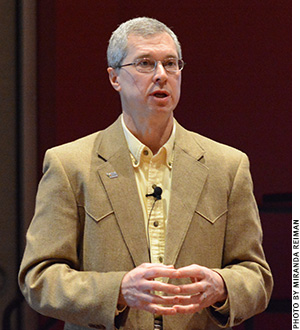Developing a Healthier, More Profitable Calf
Hilton outlines preconditioning done right.
“How many of you who sell calves want that feedlot guy to make a pile of money on your calves?” When veterinarian Mark Hilton, Purdue University, asked a crowd of producers that question during the 22nd Cattlemen’s College, hands shot up all over the room. The Feb. 4 session during the 2015 Cattle Industry Convention & NCBA Trade Show focused on one of the most important ways cattlemen can ensure profit down the line: health.
Hilton recommended a preventative approach.

Weaning is a critical time, and Mark Hilton encouraged a good preconditioning program — the longer, the better.
“I’m a low-medicine veterinarian,” he said. “I want to use management instead of medicine and money.” Producers should focus on nutrition, genetics and creating the best environment, starting from gestation until the calves are marketed.
Weaning is a critical time, and Hilton encouraged a good preconditioning program — the longer, the better.
“The more days we precondition the calves, the more profit,” Hilton said.
A 10-year analysis of Indiana beef herds showed after adjusting for expenses, like feed and medicine (including labor), preconditioning for 60 days or more generally produced $80.17 profit.
Low feed costs coupled with high cattle prices put an exclamation point on that in today’s marketplace.
“2014 was the biggest ‘no brainer’ year in history to precondition your calves,” he said. Those putting on the most weight during the postweaning phase earned $210.15 last year. “2015 could be even better.”
Hilton shared four keys to success:
- 1. Team building. Get a team of experts who are willing to continue learning with you, he said. That might include a veterinarian, nutritionist, extension personnel, etc.
- 2. Weight gain. “In preconditioning, if you’re not having those calves gain a significant amount of weight … you’re not going to have as much profit in them,” he said, sharing examples of 3-pound average daily gains (ADG) prior to feedlot arrival. “The genetics we’ve got today — they can do it. They can put it right on and not get fleshy.”
- Calves just maintain weight during the first week of preconditioning, so every additional week you keep them helps the bottom line. “We want to dilute out that first week and make it not a big deal,” Hilton said.
- 3. Herd health and nutrition. Finding the right vaccination program and its timing are essential to preconditioning success. “I’m not going to tell you what diseases to vaccinate for, because I don’t know. I’ve only practiced in two states,” he said, encouraging one-on-one consultations with a veterinarian.
- In the Indiana study, 79% of the cost of preconditioning was in the form of hay and feed, Hilton said, underscoring the importance of nutrition.
- 4. Marketing. “Build a résumé for your calves,” he said. “Your calves are special. You need to build a résumé for them.” That includes finding out more about how the calves do after weaning, either by retaining some ownership or participating in a small-scale feedout. Hilton said the bottom line is that health pays, but it pays more when marketing matches management.
“If you are not adding value to your calves, you are making a huge mistake leaving money on the table and giving my feedlot owners a lot poorer-quality cattle,” he said.
For more coverage of the 2015 Cattle Industry Convention & NCBA Trade Show, visit the Newsroom at www.4cattlemen.com.






